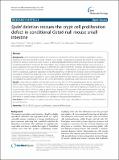| dc.contributor.author | Aronson, Boaz E | en_US |
| dc.contributor.author | Stapleton, Kelly A | en_US |
| dc.contributor.author | Vissers, Laurens ATM | en_US |
| dc.contributor.author | Stokhuijzen, Eva | en_US |
| dc.contributor.author | Bruijnzeel, Hanneke | en_US |
| dc.contributor.author | Krasinski, Stephen D | en_US |
| dc.date.accessioned | 2014-03-11T13:53:22Z | |
| dc.date.issued | 2014 | en_US |
| dc.identifier.citation | Aronson, Boaz E, Kelly A Stapleton, Laurens ATM Vissers, Eva Stokhuijzen, Hanneke Bruijnzeel, and Stephen D Krasinski. 2014. “Spdef deletion rescues the crypt cell proliferation defect in conditional Gata6 null mouse small intestine.” BMC Molecular Biology 15 (1): 3. doi:10.1186/1471-2199-15-3. http://dx.doi.org/10.1186/1471-2199-15-3. | en |
| dc.identifier.issn | 1471-2199 | en |
| dc.identifier.uri | http://nrs.harvard.edu/urn-3:HUL.InstRepos:11879834 | |
| dc.description.abstract | Background: GATA transcription factors are essential for self-renewal of the small intestinal epithelium. Gata4 is expressed in the proximal 85% of small intestine while Gata6 is expressed throughout the length of small intestine. Deletion of intestinal Gata4 and Gata6 results in an altered proliferation/differentiation phenotype, and an up-regulation of SAM pointed domain containing ETS transcription factor (Spdef), a transcription factor recently shown to act as a tumor suppressor. The goal of this study is to determine to what extent SPDEF mediates the downstream functions of GATA4/GATA6 in the small intestine. The hypothesis to be tested is that intestinal GATA4/GATA6 functions through SPDEF by repressing Spdef gene expression. To test this hypothesis, we defined the functions most likely regulated by the overlapping GATA6/SPDEF target gene set in mouse intestine, delineated the relationship between GATA6 chromatin occupancy and Spdef gene regulation in Caco-2 cells, and determined the extent to which prevention of Spdef up-regulation by Spdef knockout rescues the GATA6 phenotype in conditional Gata6 knockout mouse ileum. Results: Using publicly available profiling data, we found that 83% of GATA6-regulated genes are also regulated by SPDEF, and that proliferation/cancer is the function most likely to be modulated by this overlapping gene set. In human Caco-2 cells, GATA6 knockdown results in an up-regulation of Spdef gene expression, modeling our mouse Gata6 knockout data. GATA6 occupies a genetic locus located 40 kb upstream of the Spdef transcription start site, consistent with direct regulation of Spdef gene expression by GATA6. Prevention of Spdef up-regulation in conditional Gata6 knockout mouse ileum by the additional deletion of Spdef rescued the crypt cell proliferation defect, but had little effect on altered lineage differentiation or absorptive enterocytes gene expression. Conclusion: SPDEF is a key, immediate downstream effecter of the crypt cell proliferation function of GATA4/GATA6 in the small intestine. | en |
| dc.language.iso | en_US | en |
| dc.publisher | BioMed Central | en |
| dc.relation.isversionof | doi:10.1186/1471-2199-15-3 | en |
| dc.relation.hasversion | http://www.ncbi.nlm.nih.gov/pmc/articles/PMC3917371/pdf/ | en |
| dash.license | LAA | en_US |
| dc.subject | GATA6 | en |
| dc.subject | SPDEF | en |
| dc.subject | Crypt cell proliferation | en |
| dc.subject | Intestinal differentiation | en |
| dc.title | Spdef deletion rescues the crypt cell proliferation defect in conditional Gata6 null mouse small intestine | en |
| dc.type | Journal Article | en_US |
| dc.description.version | Version of Record | en |
| dc.relation.journal | BMC Molecular Biology | en |
| dash.depositing.author | Krasinski, Stephen D | en_US |
| dc.date.available | 2014-03-11T13:53:22Z | |
| dc.identifier.doi | 10.1186/1471-2199-15-3 | * |
| dash.contributor.affiliated | Krasinski, Stephen | |


